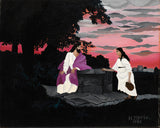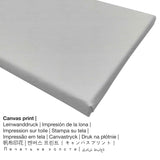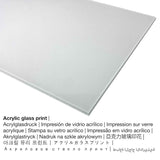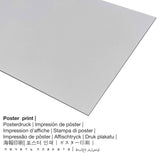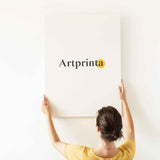Horace Pippin, 1940 - Cristo e la donna di Samaria - stampa d'arte
Tasse incluse. Spedizione calcolata alla cassa.
Specifiche del prodotto artistico
In 1940 Orazio Pipino painted the piece of art. The over 80 years old original was made with the size: Complessivamente: 19 3/4 x 24 1/4 in (50,2 x 61,6 cm) ed è stato dipinto con il mezzo olio su tela. Inoltre, l'opera d'arte può essere visualizzata in Barnes Foundation's raccolta digitale. Il arte moderna public domain piece of art is provided with courtesy of Courtesy of the Barnes Foundation, Merion and Philadelphia, Pennsylvania.The creditline of the artpiece is: . On top of that, alignment of the digital reproduction is paesaggio e ha un rapporto laterale di 1.2:1, il che lo implica la lunghezza è del 20% più lunga della larghezza.
Seleziona il materiale del prodotto che vorresti avere
In the dropdown lists next to the article you can choose the size and material of your choice. Select your preferred size and material among the following alternatives:
- Metallo (stampa dibond alluminio): Aluminium Dibond prints are metal prints with a true depth - for a modern look and non-reflective surface structure. Colors are luminous in the highest definition, the details of the print are crisp and clear. The print on aluminium is one of the most popular entry-level products and is a truly modern way to display fine art prints, as it puts 100% of the viewer’s attention on the artwork.
- Stampa su vetro acrilico (con rivestimento in vero vetro): An print on acrylic glass, which is sometimes described as a UV print on plexiglass, will turn your favorite original artwork into décor and offers a viable alternative option to dibond and canvas prints. Your work of art is being custom-made with state-of-the-art UV direct print technology. The major advantage of an acrylic glass fine art print is that contrasts as well as granular image details become exposed due to the subtle gradation.
- Stampa poster su tela: A poster print is a UV printed sheet of canvas with a slight structure on the surface. Please keep in mind, that depending on the absolute size of the canvas poster print we add a white margin of approximately 2 - 6cm round about the painting in order to facilitate the framing.
- Stampa su tela: A printed canvas, which should not be mistaken with a painting on a canvas, is a digital copy printed from a UV direct printing machine. Canvas prints are relatively low in weight. This means, it is easy and straightforward to hang up your Canvas print without extra wall-mounts. A canvas print is suitable for any kind of wall in your house.
Nota importante: We try what we can to describe the art products as clearly as possible and to showcase them visually. Nonetheless, the pigments of the printed materials and the printing may vary slightly from the image on your monitor. Depending on the settings of your screen and the nature of the surface, not all color pigments are printed 100% realistically. Bearing in mind that the are processed and printed by hand, there might also be minor deviations in the exact position and the size of the motif.
Dettagli degli oggetti strutturati
| Categorizzazione del prodotto: | stampa d'arte |
| Metodo di riproduzione: | riproduzione digitale |
| Processo di produzione: | Stampa UV / stampa digitale |
| Provenienza: | Fabbricazione tedesca |
| Tipo di scorta: | produzione su richiesta |
| Destinazione d'uso: | quadro murale, galleria murale |
| Orientamento dell'immagine: | allineamento del paesaggio |
| Dimensioni: | 1.2: 1 (lunghezza larghezza) |
| Implicazione delle proporzioni laterali: | la lunghezza è del 20% più lunga della larghezza |
| Scelte del materiale del prodotto: | stampa su metallo (dibond in alluminio), stampa su vetro acrilico (con rivestimento in vero vetro), stampa su tela, stampa su poster (carta su tela) |
| Varianti di formato della tela su telaio (stampa su tela): | 60 x 50 cm - 24 x 20 ", 120 x 100 cm - 47 x 39", 180 x 150 cm - 71 x 59 " |
| Dimensioni della stampa su vetro acrilico (con rivestimento in vero vetro): | 60 x 50 cm - 24 x 20 ", 120 x 100 cm - 47 x 39", 180 x 150 cm - 71 x 59 " |
| Varianti di stampa poster (carta tela): | 60 x 50 cm - 24 x 20 ", 120 x 100 cm - 47 x 39" |
| Stampa su alluminio (materiale dibond alluminio): | 60 x 50 cm - 24 x 20 ", 120 x 100 cm - 47 x 39" |
| Inquadratura della riproduzione artistica: | non disponibile |
Specifiche d'arte
| Nome del pezzo d'arte: | "Cristo e la donna di Samaria" |
| Classificazione: | pittura |
| Vasta categoria: | arte moderna |
| Ora: | 20th secolo |
| Creato: | 1940 |
| Età approssimativa dell'opera d'arte: | più di 80 anni |
| Mezzo originale dell'opera d'arte: | olio su tela |
| Dimensioni dell'opera d'arte originale: | Complessivamente: 19 3/4 x 24 1/4 in (50,2 x 61,6 cm) |
| Museo: | Fondazione Barnes |
| Ubicazione del museo: | Filadelfia, Pennsylvania, Stati Uniti d'America |
| pagina web Museo: | Fondazione Barnes |
| Licenza dell'opera d'arte: | dominio pubblico |
| Per gentile concessione di: | Per gentile concessione della Barnes Foundation, Merion e Philadelphia, Pennsylvania |
Panoramica dell'artista
| Artista: | Orazio Pipino |
| Conosciuto anche come: | pipino h., Pipino, Orazio Pipino, Pipino Orazio |
| Genere: | maschio |
| Nazionalità dell'artista: | americano |
| Lavori dell'artista: | pittore |
| Paese: | Stati Uniti |
| Classificazione dell'artista: | artista moderno |
| Morì invecchiato: | 58 anni |
| Anno di nascita: | 1888 |
| Nato a (luogo): | West Chester, Chester county, Pennsylvania, Stati Uniti |
| L'anno è morto: | 1946 |
| Posto di morte: | West Chester, Chester county, Pennsylvania, Stati Uniti |
Diritto d'autore ©, Artprinta.com (Artprinta)
Additional artwork information by the museum's website (© Copyright - by Barnes Foundation - Fondazione Barnes)
The picture shocks by its drama, which is due primarily to Pippin's original use of color. The intense gradations of fuchsia and gray in the sky meet dramatically at the horizon with an intense purplish red against the green-blacks of the foliage. The placement of Christ's crisp, silhouetted purple cloak, firmly situated as if in a niche between the well and stones and the dark foliage behind, is a powerful color statement.Barnes believed that Pippin had been influenced by the composition of a painting formerly attributed to Tintoretto (Christ and the Woman of Samaria, BF823) of the same subject in the Foundation. The painting conceivably has another source rooted in African American experience, specifically, Pippin's deep religious faith. One of the fundamental aspects of Barnes's attraction to Pippin's work and his reference to its "counterparts in the Spirituals of the American Negro" was their shared love for the powerful emotions evoked by the simplicity, directness, and rhythms of that indigenous music. It is likely that Pippin, familiar with a wide repertoire of accompanied and a cappella songs, knew the traditional spiritual "Jesus Met the Woman at the Well". Richard J. Wattenmaker, American Paintings and Works on Paper in the Barnes Foundation (Merion, PA: The Barnes Foundation; New Haven: Yale University Press, 2010), 307-9.

